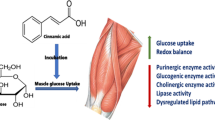Abstract
Carnosine, a β‐alanyl‐L‐histidine dipeptide with antioxidant properties is present at high concentrations in skeletal muscle tissue. In this study, we report on the antioxidant activity of carnosine on muscle lipid and protein stability from both in vitro and in vivo experiments. Carnosine inhibited lipid peroxidation and oxidative modification of protein in muscle tissue prepared from rat hind limb homogenates exposed to in vitro Fenton reactant (Fe2+, H2O2)‐generated free radicals. The minimum effective concentrations of carnosine for lipid and protein oxidation were 2.5 and 1 mM, respectively. Histidine and β‐alanine, active components of carnosine, showed no individual effect towards inhibiting either lipid or protein oxidation. Skeletal muscle of rats fed a histidine supplemented diet for 13 days exhibited a marked increase in carnosine content with a concomitant reduction in muscle lipid peroxidation and protein carbonyl content in skeletal muscle caused by subjecting rats to a Fe‐nitrilotriacetate administration treatment. This significant in vitro result confirms the in vivo antioxidant activity of carnosine for both lipid and protein constituents of muscle under physiological conditions.
Similar content being viewed by others
References
Crush KG: Carnosine and related substances in animal tissues. Comp Biochem Physiol 34: 30, 1970
Jackson MC, Lenney JF: The distribution of carnosine and related dipeptides in rat and human tissues. Inflamm Res 45: 132–135, 1996
Plowman JF, Close EA: An evaluation of a method to differentiate the species of origin of meats on the basis of the contents of anserine, balenine and carnosine in skeletal muscle. J Sci Food Agric 45: 69–78, 1988
Harris RC, Marlin DJ, Dunnett M, Snow DH, Hultman E: Muscle buffering capacity and dipeptide content in the thoroughbred horse, greyhound dog and man. Comp Biochem Physiol 97A: 249–251, 1990
Snyder SH: Brain peptides as neurotransmitters. Science 209: 976–983, 1980
Johnson P, Hammer JL: Effect of L-1-methylhistidine and the muscle dipeptides carnosine and anserine on the activities of muscle calpains. Comp Biochem Physiol 94B: 45–48, 1989
Decker EA, Crum AD, Calvert JT: Differences in the antioxidant mechanisms of carnosine in the presence of copper and iron. J Agric Food Chem 40: 756–759, 1992
Decker EA: The role of phenolics, conjugated linoleic acid, carnosine, and pyrroloquinoline quinone as nonessential dietary antioxidants. Nutr Rev 53: 49–58, 1995
Chan WKM, Decker EA, Lee JB, Butterfield DA: EPR spin trapping studies of the hydroxyl radical scavenging activity of carnosine and related depeptides. J Agric Food Chem 42: 1407–1410, 1994
Hipkiss AR, Brounson C: A possible new role for the anti-ageing peptide carnosine. Cell Mol Life Sci 57: 747–753, 2000
Horning MS, Blakemore LJ, Trombley PQ: Endogenous mechanisms of neuroprotection: Role of zinc, copper, and carnosine. Brain Res 852: 56–61, 2000
American Institute of Nutrition: Report of American Institute of Nutrition ad hoc committee on standards for nutritional studies. J Nutr 107: 1340–1348, 1977
Oliver CN, Ahn B, Moerman EJ, Goldstein S, Stadtman ER: Age-related changes in oxidized proteins. J Biol Chem 262: 5488–5491, 1987
Cao G, Cutler RG: Protein oxidation and aging. I. Difficulties in measuring reactive protein carbonyls in tissues using 2,4-dinitrophenylhydrazine. Arch Biochem Biophys 320: 106–114, 1995
Nagasawa T, Hatayama T, Watanabe Y, Tanaka M, Niisato Y, Kitts DD: Free radical-mediated effects on skeletal muscle protein in rats treated with Fe-nitrilotriacetate. Biochem Biophys Res Commun 231: 37–41, 1997
Markwell MAK, Hass SM, Biebra LL, Tolbert NE: A modification of the Lowry procedure to simplify protein determination in membrane and lipoprotein samples. Anal Biochem 87: 206–210, 1986
Nagasawa T, Sakai T, Onodera R: Simple and sensitive determination of plasma Nτ-methylhistidine by high-performance liquid chromatography using pre-column derivative formation with o-phthalaldehyde-2-mercaptoethanol. J Chromatogr 566: 223–227, 1991
Hipkiss AR, Worthington VC, Himsworth DTJ, Herwig W: Protective effects of carnosine against protein modification mediated by malondialdehyde and hypochlorite. Biochim Biophys Acta 1380: 46–54, 1998
Kohen R, Yamamoto Y, Cundy KC, Ames BN: Antioxidant activity of carnosine, homocarnosine, and anserine present in muscle and brain. Proc Natl Acad Sci USA 85: 3175–3179, 1988
Yoshikawa T, Naito Y, Tanigawa T, Yoneta T, Kondo M: The antioxidant properties of a novel zinc-carnosine chelate compound, N(3-aminopropionyl)-L-histidine to zinc. Biochim Biophys Acta 1115: 15–22, 1991
Wada AM, Tucker HN: Antioxidant characteristics of L-histidine. J Nutr Biochem 9: 308–315, 1998
Hipkiss AR, Chana H: Carnosine protects proteins against methylglyoxal-mediated modifications. Biochem Biophys Res Commun 248: 28–32, 1998
Uchida K, Fukuda A, Kawakishi S, Hiai H, Toyokuni S: A renal carcinogen ferric nitrilotriacetate mediates a temporary accumulation of aldehyde-modified proteins within cytosolic compartment of rat kidney. Arch Biochem Biophys 317: 405–411, 1995
Uchida K, Sakai K, Itakura K, Osawa T, Toyokuni S: Protein modification by lipid peroxidation products: Formation of malondialdehydederived Nɛ-(2-propenal)lysine in proteins. Arch Biochem Biophys 346: 45–52, 1997
Zhou S, Decker EA: Ability of carnosine and other skeletal muscle components to quench unsaturated aldehydic lipid peroxydation products. J Agric Food Chem 47: 51–55, 1999
Tamaki N, Morioka S, Ikeda T, Harada M, Hama T: Biosynthesis and degradation of carnosine and turnover rate of its constituent amino acids in rats. J Nutr Sci Vitaminol 26: 127–139, 1980
Tamaki N, Funatsuka A, Fujimoto S, Hama T: The utilization of carnosine in rats fed on a histidine-free diet and its effect on the levels of tissue histidine and carnosine. J Nutr Sci Vitaminol 30: 541–551, 1984
Author information
Authors and Affiliations
Corresponding author
Rights and permissions
About this article
Cite this article
Nagasawa, T., Yonekura, T., Nishizawa, N. et al. In vitro and in vivo inhibition of muscle lipid and protein oxidation by carnosine. Mol Cell Biochem 225, 29–34 (2001). https://doi.org/10.1023/A:1012256521840
Issue Date:
DOI: https://doi.org/10.1023/A:1012256521840




